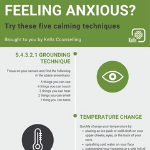The Canadian Mental Health Association (CMHA) research shows that Canadians are experiencing intensified feelings of stress and anxiety as the COVID-19 pandemic continues.
Anxiety is normal; it’s your body’s natural response to stress. For instance, if you’re starting a new job or meeting someone new, you’re bound to feel worried. Usually, once the situation is over, your anxious feelings settle and you feel fine again.
Sometimes, however, that is not the case and anxiety can cause emotional and physical reactions that interfere with your daily life. Identifying the symptoms can help you to move forward to overcome the anxiety.
Emotional symptoms can include:
- Feeling restless, tense, or irritable
- Troubles with concentration or memory
- Racing or repetitive thoughts
- Over-sensitivity, crying, or tearfulness
- Avoidance of situations
- Having a sense of impending danger, panic, or doom
Physical reactions can include:
- Shallow, rapid breathing
- Sleep issues
- Feeling weak or fatigued
- Muscle tension
- Dry mouth
- Gastrointestinal (GI) issues
- Feeling dizzy or faint
- Appetite changes
- Headaches
- Increased heartbeat
- Sweating
- Shaking or tremors
Managing Symptoms of Anxiety
Start out by paying attention to your body and moods. When you feel anxiety spiking, list what events, smells, or sounds might be triggers. State these out loud, so the ‘internal connections’ are externalized. Once you learn to recognize and accept anxiety, it can no longer control you, and you will begin to move forward!
Four Ways to Calm Down
The following techniques can be used to quickly calm yourself down.
Download this handy infographic to post the tools where they are easily accessible.
5.4.3.2.1 – Grounding Technique
Focus on your senses and find the following in the space around you:
- 5 things you can see.
- 4 things you can touch.
- 3 things you can hear.
- 2 things you can smell.
- 1 thing you can taste.
Paced Breathing
The trick to calming anxious breathing down is properly pacing it.
Focus on your breathing. Take a short inhale (count to four) through your nose, and then a long exhale (count to seven) through your mouth, as if you are breathing through a straw.
Do this for a few minutes to lower your heart rate and anxiety. Remember, it is not a deep breath … instead it is quick in and long out.
Temperature Change
To bring your heartrate and anxiety down quickly, change your body temperature by placing an ice pack or cold cloth just under your eyes or on the back of your neck. If that doesn’t slow your racing heart, splash cold water on your face or submerge your forearms into a sink full of cold water. It will take about 30 seconds for your body to lower your heart rate.
Muscle Relaxation
Slowly scan your body from head to toe.
Consciously tense a muscle group, hold and count to five, and then release it. Do this for every major muscle group.
Breathe in while tensing and out while relaxing. Focusing on the body sensations allows you to feel grounded in your body.
You might still need some help…
If after trying these techniques you’re still anxious, consider talking to a psychologist who can help you learn to manage anxiety.
Kells psychologists are accepting clients and would be happy to help you maintain your mental health in these unique times. Book an appointment here.


